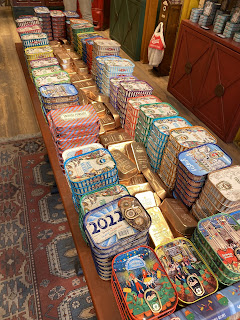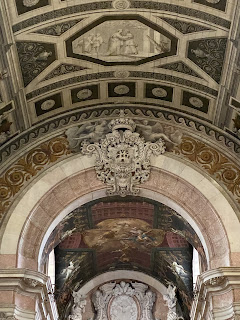Yesterday was a busy day of just wandering. I predominantly stayed around the neighborhood where I am staying and the area where I was to join a group for an evening of eating traditional foods and wine. I walked into a few churches and took pictures of the architecture and buildings around me. Today I had planned to go to a few specific monuments/museums/churches on my list, but it was a miserable day full of cold weather and rain, so I did a very touristy thing - I took a city bus tour thinking that I could stay warm and dry and yet see places I’d want to visit on Monday. It was probably one of the worse city bus tours I’ve ever been on - saw almost nothing except mostly modern Lisbon buildings from the 1950’s, 60’s, and 70’s which seem rather dated today.
I’ve uploaded pictures below with commentary when needed or known. The tablet uploads things at whim so there isn’t any rhyme or reason to the order it decides to put them in. Sometimes, if it’s really out of place, I’ve deleted it and put it back in, in the right place. But there are so many pictures, it’s hard to do that with all of them.
The best part of yesterday was the food tour. More than anything else here in Portugal, I’ve appreciated the food. For the most part it is simple, but extremely well prepared.
Many of the buildings have tile work on the outside of them. Each is quite colorful and unique. This one is on a rounded corner.
Canned Fish of all different varieties:
The hills are rough to climb from one neighborhood to another, so they’ve added several elevators throughout the city. This one is the most impressive. There’s also a restaurant/bar at the top. But it costs 5 euros to ride it and at busy times, you need to wait in a long line. It is faster (and certainly cheaper) just to walk up the hill/steps. A month ago, I would have waited in line even if it cost 20 euros. Thankfully, climbs like this are easily accomplished now with the amount of walking and stairs I’ve had to do.
These are tempura green beans that I had for lunch with an amazing cabbage, potato, and chorizo soup.
This building in the Chiada neighborhood had once been a palace. Now it houses specialty stores and a restaurant.
This is the oldest operating bookstore in the world - since 1732.
Churches: This first one, just celebrated 500 years.
This church is Igreja de Sao Roque:
This church is called: Basilica dos Martires:
You’ll notice in these churches, the organ and choir are up in the loft rather than the Choir Box in the center of the church like the ones in Spain.
This tartlet was so good! Almonds and caramel.
For dinner I met Samuel, our host, who took us on a history/food tour. He was fantastic and talked about the history of Portugal and how that affected the food that the people of Portugal eat.
Our first stop was for Ginjinha: this is an alcoholic beverage made of sour cherries. You only sip a shot glass of it, as it is pretty high in alcohol content. It is a family run business that has been in the family since the 1800’s. There are “national treasure” stores like this throughout Portugal, Lisbon especially, and they have national recognition with a registry certificate with the government. Being granted a certificate protects the business from ever having to be forced out by a new building owner. In other words, if someone buys the building where these businesses conduct their business, they can not get rid of them as they are deemed by the government to be of special value to the local economy and characteristic of what makes Portugal, Portugal. This place is one of those.

Our second stop was at typical Portuguese restaurant where we shared a few dishes like Octopus Salad, Bacalhau cakes, and Ovos mexidos (Scrambled Eggs) with farinheira. Codfish (Bacalhau) is Portugal’s national dish and is made many different ways. What’s unique about it, is that Codfish are not indigenous to the waters near Portugal, but can only be found in the northern colder waters near Canada and Norway. So the Portuguese import ALL of the food that has become their national dish. I’ve heard a variety of reasons why - some legend, some myth, some facts. The real story is probably a mix of them all. But what Sam talked about for our tour was about Farinheira. It is a sausage that today is made of mostly wheat flour, pork, and pork fat. It is cooked, the casing is peeled off, and it is cooked again such as panfried as slices. However, many years ago the Moslems and the Jews were expelled from Portugal when the Christians came to power. Those who stayed were forced to convert to Christianity. One of the ways to prove that you had done so was to “eat pork” which both Moslems and Jews do not do. Many of them concealed the fact that they stayed true to their own faith by being a bit deceptive in this. They gathered stale bread from the day before, the broth and fat and renderings of all the meat cooked from the day before (but obviously no pork) and mixed these together with herbs and spices, then they would put them in intestinal casings and hang them in their kitchens. Made this way, with those ingredients, they looked just like pork sausages. It was my favorite dish of the evening!


Our third stop was at an African restaurant, in the Alfama neighborhood. This is the neighborhood that is high up on the hill where many of the immigrants came and settled in Portugal providing a large amount of the work force for the country. In a city of 3 million - 700,000 of them are immigrants. We ate a traditional dish called Massamba with Chamussas. I didn’t get a picture of the Chamussa. We know it in the states as a Samosa - which are fried triangles of dough filled with meat or veggies. Massamba is a hearty cooked dish of vegetables, coconut milk and broth usually served with beans and rice.
Our fourth stop was a non-traditional restaurant. It was more like a specialty store selling made in Portuguese products that had a few tables and chairs and a tiny kitchen behind the counter to also serve food and alcohol. Here we had the most delicious, sumptuous cheese I’ve ever had with charred chorizo sausage, olives, tomato jam and bread.

And finally at our fifth location we had dessert. Almond pie and egg pudding. We had a variety of wines that I can’t even begin to remember - white, red, sweet, robust, sparkling and a moscato.

There were seven of us all together including Sam, our host. There was a couple from India who had moved to London 20 years ago, a young girl from London who had just moved there from Dallas to work on her Master’s Degree and her parents who were also from Dallas. The father of the young girl had been born of all places in Sewickley, PA (where I live) and had grown up in Baldwin/Whitehall (very close to where I work). So, he and I had a lot to talk about. During the evening discussions over dinner, I found out that Samuel was a Presbyterian and went to the Presbyterian Church here in Lisbon. After the evening was over, Hita and JZ the other couple from London and I took a long walk together and went to pink street, near my apartment to see the sights of our own neighborhood as they were also staying close by. It was a very enjoyable evening.
I’ve looked at today’s pictures and they are pretty awful since it rained the whole day. After so much food from the night before, I only had a quick cup of coffee and pastry in the morning then an early dinner. So I’ll post my dinner pictures. In the opposite order: dessert was just a small variety of these tiny cookies. My favorite were the top left and bottom right. I have no idea what they were. The middle picture is my main course - Codfish with a Shrimp Purée and Bechamel Sauce with chips. My appetizer was something they listed on the menu as a “dry cheese” and crackers. The cheese was hard and dry on the outside but softer on the inside. It was a mild cheese with not a lot of flavor to it.















































































No comments:
Post a Comment